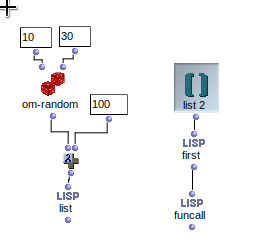Is there an easy functional, written code equivalent to pressing “v” to evaluate an instance in OM? In other words, if I somehow knew the name of an instance, is there an easy way to write a function that looks something like
(defun push-v (name-of-instance) (something that does the same thing as pushing v on name-of-instance)) ?
Or , put another way, bypassing the visual interface. (As you might guess, I’m dealing with a dynamic instance, an unlocked box, linked to code, that renders differently upon successive evaluations) In this case, I see that the picture is always called “PICTURE 2” when I examine the lisp file of the patch, but of course the Listener shows the different renderings when I evaluate.
OM => #<picture 200AF35F>
OM => #<picture 200B7ABF>
OM => #<picture 2980B09F>
etc
Thanks in advance!



